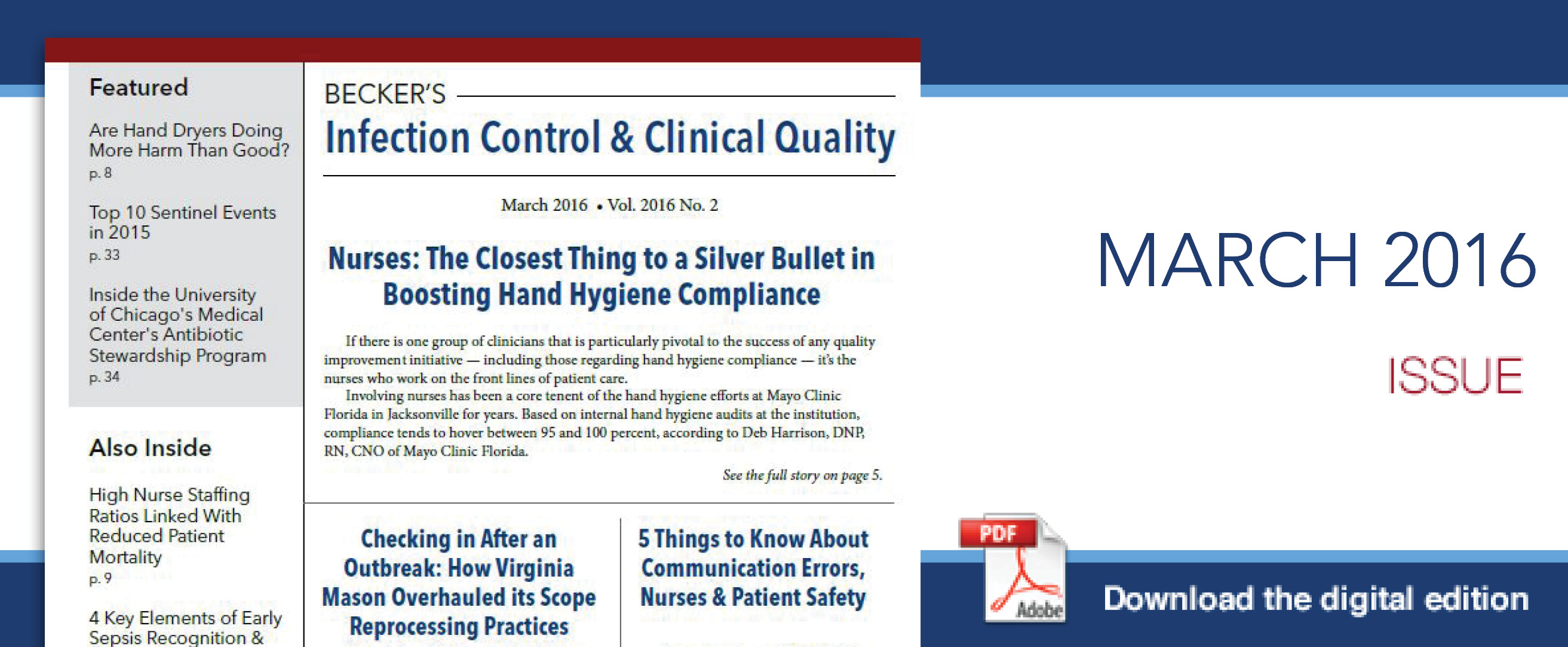March Issue of Becker's Infection Control and Clinical Quality
On the Cover
|
|
If there is one group of clinicians that is particularly pivotal to the success of any quality improvement initiative — including those regarding hand hygiene compliance — it’s the nurses who work on the front lines of patient care. |
|
|
Checking in after an outbreak: Q&A with Dr. Andrew Ross on how Virginia Mason overhauled its medical scope reprocessing practices |
 |
5 thing to know about communication errors, nurses and patient safety |
HAND HYGIENE
The eyes have it: Using visual stimuli boosts hand hygiene compliance
A study conducted at Mayo Clinic Florida in Jacksonville reveals using passive visual stimuli encourages self-directed hand hygiene compliance among healthcare staff. Click here to continue>>
Compliance falls shortest on WHO's fifth moment of hand hygiene: 3 study findings
Of the World Health Organization's Five Moments for Hand Hygiene, compliance tends to be lowest on the final step, according to a study published in the American Journal of Infection Control. Click here to continue>>
Memorial Hermann reduces HAIs with hand hygiene tool
In 2010, Houston-based Memorial Hermann Health System implemented a Joint Commission tool to improve hand hygiene in 12 of its hospitals. Click here to continue>>
Flashing lights improve hand hygiene compliance, study finds
Research has shown flashing lights can help increase hand hygiene compliance in healthcare settings, but the longevity of the effect has not been examined — until now. Click here to continue>>
Putting hand sanitizer in high-traffic areas ups use 528%
A hospital relocated its hand sanitizer dispenser from the side of the lobby to in the middle of the lobby and saw use skyrocket 528 percent, according to a study published in the March issue of the American Journal of Infection Control. Click here to continue>>
NURSES AND PATIENT SAFETY
Are hand dryers doing more harm than good? 5 things to know
High-speed jet air dryers commonly found in public restrooms are germ-spreading machines, according to a new study published in the Journal of Applied Microbiology. Click here to continue>>
5 thing to know about communication errors, nurses and patient safety
Approximately one-third of malpractice cases involving nursing cite a breakdown in communication, according to the recently published "Malpractice Risks in Communication Failures: 2015 Annual Benchmarking Report". Click here to continue>>
High nurse staffing ratios linked with reduced patient mortality: 3 study findings
A recent study published in the online journal BMJ Open suggests higher nurse staffing levels are directly linked to lower patient mortality rates. Click here to continue>>
Less than 20% of nurses comply with standard precautions for infection prevention
Just 17.4 percent of ambulatory care nurses reported that they comply with all nine standard precautions for infection prevention, according to a study in the American Journal of Infection Control. Click here to continue>>
Magnet-recognized hospitals for nursing have better surgical outcomes
Patients undergoing surgery at hospitals Magnet-recognized for nursing excellence are more likely to have better outcomes at lower costs, according to research from the Philadelphia-based University of Pennsylvania, published in JAMA Surgery. Click here to continue>>
INFECTION CONTROL AND PATIENT SAFETY
Evidence-based healthcare: Not a top priority for hospitals, survey of nurses finds
Use of evidence-based practices remains low at several United States hospitals, even though use of such practices has been linked to higher care quality, better patient experiences and lower costs, according to a study in Worldviews on Evidence-Based Nursing. Click here to continue>>
Combat UV light disinfection misconceptions with just one step
The concept of using ultraviolet light to disinfect isn't necessarily a new one, but it has gained more attention in recent years, thanks to the push for transparency around infection rates and the financial penalties attached to healthcare-acquired infections and readmissions. Click here to continue>>
4 key elements of early sepsis recognition and response
An official from Houston Methodist Hospital shared lessons learned from the organizations' sepsis care improvement initiative implementation in the March 2016 edition of The Joint Commission Journal on Quality and Patient Safety. Click here to continue>>
Predictive preventive model reduces C. diff cases in ICU: 3 study findings
Researchers found a predictive screening tool and preventive model helped reduce healthcare-acquired Clostridium difficile infections in a study published in the American Journal of Infection Control. Click here to continue>>
Can chlorhexidine wipes prevent drug-resistant HAIs in the ICU?
Researchers in Bangkok recently examined the effectiveness of daily bathing with 2 percent chlorhexidine-impregnated washcloths in preventing multidrug-resistant gram-positive bacterial colonization and bloodstream infection. Click here to continue>>
Sepsis redefined: JAMA articles update guidance for the first time since 2001
A series of articles published in JAMA based on National Institutes of Health-funded research update the definition of sepsis and provide a more robust framework for clinicians and patients to treat the common hospital-acquired infection. Click here to continue>>
How clean is clean-shaven? Study finds beardless healthcare workers carry more bacteria on their faces
A clean-shaven face may be deceptive, at least when it comes to the "clean" part, according to a Journal of Hospital Infection study that found healthcare workers with beards carried fewer harmful bacteria than those with less facial hair. Click here to continue>>
Major C. diff hospital collaboration reduces infections by 36 percent
A collaboration between four New York state hospitals aimed at reducing Clostridium difficile infections resulted in a 36 percent drop in rates of the common hospital-acquired infection in September 2015, compared with 2011 levels, according to a Wall Street Journal report. Click here to continue>>
Checking in after an outbreak: Q&A with Dr. Andrew Ross on how Virginia Mason overhauled its medical scope reprocessing practices
Duodenoscopes are intricate, snakelike instruments used in more than 500,000 procedures each year in the U.S. Click here to continue>>
6 best practices from AORN's forthcoming endoscope reprocessing guidelines
The Association of periOperative Registered Nurses plans to release an update to its "Guideline for Processing Flexible Endoscopes" on Feb. 1, but the lead author of the guideline update offered a sneak peek at some of the soon-to-come best practices. Click here to continue>>
Rigid containers vs. wrapped instrument trays: Which offers better protection from bacteria?
When compared to rigid containers, wrapped instrument trays were better at preventing bacterial ingress into a sterilized tray, according to a study in the American Journal of Infection Control. Click here to continue>>
4 strategies to prevent unintended retention of foreign objects
According to The Joint Commission's Sentinel Event Database, unintended retained foreign objects continue to be an issue for accredited organizations. Click here to continue>>
Dr. Peter Pronovost: 9 necessary patient safety growth areas
The patient safety movement "still has some growing up to do," according to Peter Pronovost, MD, PhD, director of the Armstrong Institute for Patient Safety and Quality at Johns Hopkins University in Baltimore. Click here to continue>>
Top 10 sentinel events in 2015
In 2015, the Joint Commission reviewed 936 sentinel events that occurred in hospitals, ambulatory care settings and other care locations, up dramatically from the 764 events it reviewed in 2014. Click here to continue>>
ANTIBIOTIC RESISTANCE & STEWARDSHIP
What can hospitals do to take a stand against antibiotic resistance? Inside the University of Chicago Medical Center's stewardship program
Picture a world where antibiotics don't work. Click here to continue>>
CDC, American College of Physicians issue new guidelines on antibiotic prescription
Addressing physician mishandling of antibiotic testing and prescription is a key focus of new clinical guidelines for antibiotic stewardship issued by the CDC in partnership with the AmericanCollege of Physicians. Click here to continue>>
Behavioral 'nudges' help reduce antibiotic prescriptions among physicians
Appealing to clinicians' competitive nature and desires to strengthen their reputations may be an effective method for significantly reducing unnecessary antibiotic prescriptions, according to new research from JAMA. Click here to continue>>
VA leads the way in antibiotic stewardship efforts: 5 things to know
A new Society for Healthcare Epidemiology of America study shows antibiotic stewardship practices are widely implemented at Veterans Administration-affiliated facilities. Click here to continue>>
Serving antibiotic-free meat proves difficult for some hospitals
With antibiotic resistance in the spotlight, scientists have urged hospitals to drop meat from their menus that comes from animals given antibiotics. Click here to continue>>
Research highlights how antibiotics enable C. diff infections
Growth of Clostridium difficile, the harmful bacteria responsible for many hospital-acquired infections, is normally inhibited by bile acids altered by healthy microbes in the gut. Click here to continue>>
Antiseptic baths in ICUs shown to not increase drug-resistance in MRSA
Chlorhexidine, an antiseptic used to bathe patients in intensive care units to prevent infection has been shown not to increase drug resistance in pathogens responsible for hospital-acquired infections, according to an Infection Control & Hospital Epidemiology study. Click here to continue>>
CMO, CNO and Chief Quality Officer Moves
7 recent hospital and health system CNO, CMO moves
The following seven hospital and health system CNO and CMO moves occurred or were announced in the last month, starting with the most recent. Click here to continue>>
Click here to view the featured stories and download a pdf of the issue.




